Maine, known for its breathtaking landscapes, is also home to a variety of bird species, including a selection of beautiful blue birds. Our comprehensive Free Photo Guide is designed to help you identify and learn about the different blue birds found in this spectacular state.
From common sightings to rare encounters, this guide covers it all, providing you with detailed information, tips on where to spot blue-colored birds, and, of course, beautiful photographs to help with identification.
Ready to dive into the world of blue birds in Maine? Grab your binoculars, your camera, and our Free Photo Guide, and let’s get started!
Blue Birds Found In Maine
Maine’s diverse geography provides a variety of habitats for birds, making it a haven for birdwatchers. The state’s vast forests are home to many different species of birds, including a number of blue birds.
Maine’s long coastline and numerous lakes and rivers attract a variety of waterfowl and wading birds. The state’s position along the Atlantic Flyway, a major bird migration route, also means that a large number of migratory birds pass through each year, adding to the diversity of species that can be seen.
Eastern Bluebird
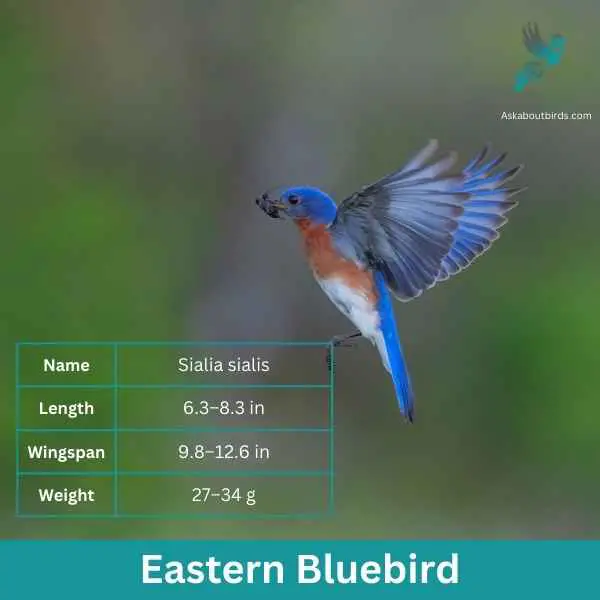
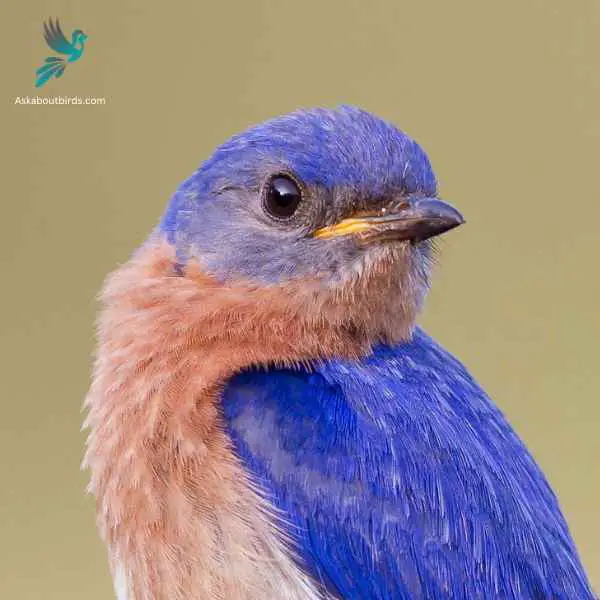
| Feature | Measurement |
|---|---|
| Scientific Name | Sialia sialis |
| Length | 6.3–8.3 in |
| Wingspan | 9.8–12.6 in |
| Weight | 27–34 g |
The Eastern Bluebird (Sialia sialis) is a small thrush found in open woodlands, farmlands, and orchards, and is recognized for its vibrant blue and red coloration. Male Eastern Bluebirds are dazzling with bright blue upperparts and a rusty or brick-red throat and breast, while females, though less colorful, still offer a similar pattern. The bird is native to North America and is commonly seen east of the Rockies, from Canada to the Gulf States and southeastern Arizona to Nicaragua.
Eastern Bluebirds feed on insects, wild fruit and berries. They have a gentle nature and are often seen perched alone or in small groups in the open, scanning the ground for prey. They are cavity nesters and will use old woodpecker holes or birdhouses if they are the right size.
Indigo Bunting


| Feature | Measurement |
|---|---|
| Scientific Name | Passerina cyanea |
| Length | 4.5–5.1 in |
| Wingspan | 7.1–9.1 in |
| Weight | 11.2–21.4 g |
The Indigo Bunting is a strikingly vibrant songbird, often hailed for its brilliant blue plumage and melodic song that graces woodlands and meadows during the warmer months.
Appearance: Males are renowned for their bright indigo blue feathers, which can appear darker in certain lights. Females and juveniles, on the other hand, are brown with subtle hints of blue on their wings and tail. The species lacks the vibrant streaking or spotting commonly found in many other songbirds.
Diet: Indigo Buntings primarily subsist on seeds, especially during non-breeding seasons. During the breeding season, they also consume a variety of insects such as beetles, caterpillars, and spiders, providing essential protein for their growing chicks.
Reproduction: Indigo Buntings build their nests close to the ground in shrubs or low tree branches. These nests, crafted meticulously with grasses and other plant materials, cradle clutches of typically 3 to 4 eggs. After hatching, the young are fed by both parents until they’re ready to fledge.
Blue Jay

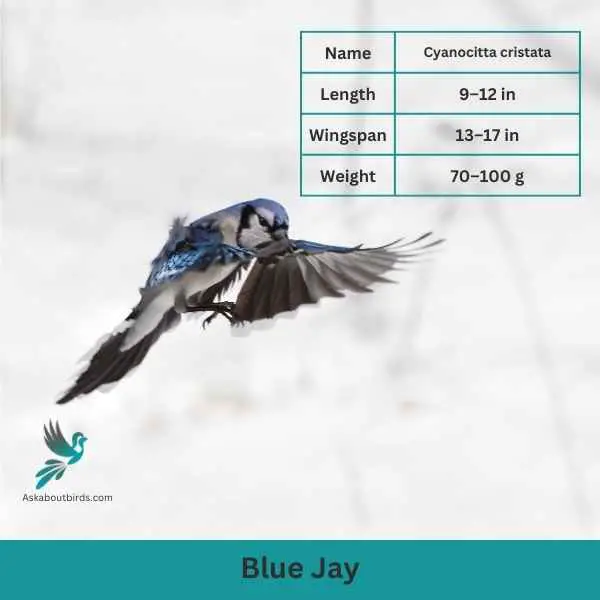
| Feature | Measurement |
|---|---|
| Scientific Name | Cyanocitta cristata |
| Length | 9–12 in |
| Wingspan | 13–17 in |
| Weight | 70–100 g |
The Blue Jay is a vibrant and easily recognized bird, known for its intelligence, distinctive calls, and bold behavior, commonly found throughout the eastern and central United States.
Appearance: The Blue Jay sports a striking blue upper body with white and black markings. Its face has a pronounced white patch with a black necklace that runs across the throat and around the head. The bird also features a pronounced blue crest, which can be raised or lowered, and its wings and tail are brightly colored with black bars and white tips.
Diet: Blue Jays are omnivores. Their diet consists primarily of seeds, nuts, especially acorns, fruits, and small insects. They’ve also been known to eat eggs or nestlings of other birds occasionally. Blue Jays often store food items in caches to eat later.
Reproduction: Blue Jays are monogamous birds that form long-lasting pair bonds. They typically build their nests in trees or large shrubs, constructing them from twigs, grass, and sometimes using mud as a binder. The female lays a clutch of 3 to 6 eggs, which are pale blue or sometimes white with brown speckles.
Cliff Swallow
Scientific Name: Petrochelidon pyrrhonota Length: 5-6 in (13-15 cm) Wingspan: 11-12 in (28-30 cm) Weight: 0.7-1 oz (20-28 g)
The Cliff Swallow is a small, agile bird known for its characteristic mud nests, social behavior, and long-distance migrations.
Appearance: Cliff Swallows have a distinctive appearance with a dark blue back, a cream-colored forehead, an orange-brown rump, and a buffy or whitish underbelly. They also have a square or slightly notched tail.
Diet: The diet of Cliff Swallows primarily consists of flying insects, including flies, beetles, and wasps, which they catch in the air while flying.
Reproduction: Cliff Swallows are known for building gourd-shaped mud nests, often in colonies on vertical cliff faces, bridges, or buildings. The female typically lays a clutch of 3 to 6 white eggs. Both parents participate in incubating the eggs and feeding the chicks.
Purple Martin
Scientific Name: Progne subis
Length: 7.5-9.1 in (19-23 cm)
Wingspan: 15.3-16.1 in (39-41 cm)
Weight: 1.9-2.3 oz (55-65 g)
The Purple Martin is a popular and widely recognized bird species, known for its acrobatic flight and social behavior.
Appearance: Purple Martins have a dark, glossy purple-blue plumage. Males are almost entirely dark purple while females and young birds have a lighter, greyish belly and throat.
Diet: The diet of Purple Martins primarily consists of flying insects such as beetles, flies, dragonflies, and moths. They catch their prey in mid-air while flying.
Reproduction: Purple Martins nest in colonies, often using artificial nest boxes provided by humans. The female typically lays a clutch of 4 to 6 white eggs, and both parents participate in incubating the eggs and feeding the chicks.
Tree Swallow
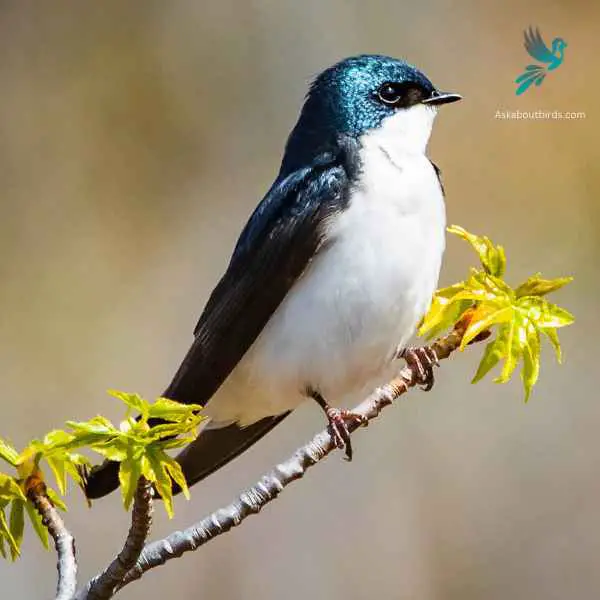
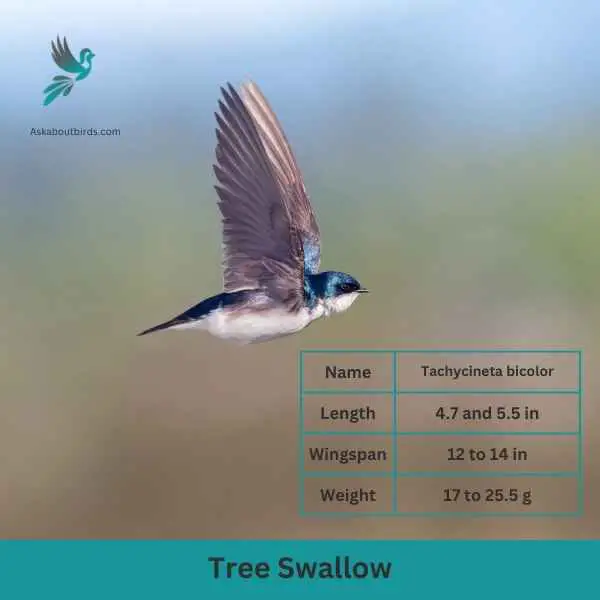
| Feature | Measurement |
|---|---|
| Scientific Name | Tachycineta bicolor |
| Length | 4.7 and 5.5 in |
| Wingspan | 12 to 14 in |
| Weight | 17 to 25.5 g |
The Tree Swallow is a graceful and agile bird, best recognized for its iridescent blue-green upperparts and sweeping flight patterns over open fields and water.
Appearance: The Tree Swallow is sleek with a streamlined body. The upperparts shine with a blue-green iridescence while the underparts are white. They possess long, pointed wings and a slightly forked tail, aiding in their agile flight.
Diet: Tree Swallows primarily feed on flying insects, skillfully catching them mid-air. During colder months when insects are scarce, they can switch to a diet of berries, particularly those of the bayberry, which other birds might find hard to digest.
Reproduction: Tree Swallows are cavity-nesters, typically choosing natural holes in trees or using bird boxes. They line their nests with feathers, creating a soft environment for the eggs. The female will lay a clutch of 4 to 7 white eggs.
Barn Swallow


| Feature | Measurement |
|---|---|
| Scientific Name | Hirundo rustica |
| Length | 6.5–7.5 in |
| Wingspan | 12.5–13.5 in |
| Weight | 16–22 g |
The Barn Swallow is a sleek, agile bird renowned for its graceful flight patterns and iconic forked tail, often seen darting over fields and water bodies in search of flying insects.
Appearance: Barn Swallows have deep blue, almost iridescent, upperparts and a rufous to tawny underbelly. Their distinctively forked tail and long wings give them a streamlined look. Both males and females have a similar appearance, though males often exhibit slightly brighter colors and a deeper fork in the tail.
Diet: Barn Swallows feed primarily on flying insects, which they catch in mid-air during their agile and acrobatic flights. Their diet includes flies, beetles, moths, and other small flying insects.
Reproduction: Barn Swallows are known for building their mud nests on man-made structures, particularly barns, bridges, and eaves. The nest is cup-shaped and made from mud pellets, often lined with feathers. The female lays a clutch of 4 to 6 eggs.
Belted Kingfisher

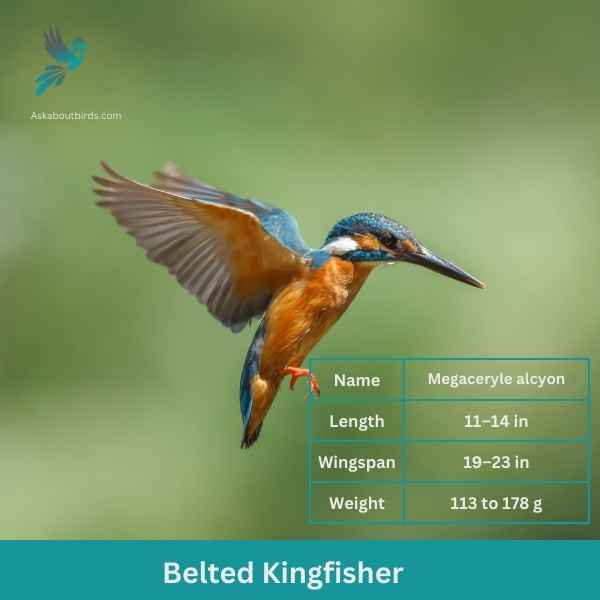
| Feature | Measurement |
|---|---|
| Scientific Name | Megaceryle alcyon |
| Length | 11–14 in |
| Wingspan | 19–23 in |
| Weight | 113 to 178 g |
The Belted Kingfisher is a distinctive and easily recognizable bird, frequently observed near water bodies, where it can be seen diving headfirst to catch prey.
Appearance: Sporting a prominent crest, the Belted Kingfisher has a slate blue-gray upper body and white underparts. Males possess a single blue band across their white chests, while females have an additional rufous band, making them one of the few bird species where females are more brightly colored than males. Their bill is long, sharp, and dagger-like.
Diet: As expert fishers, Belted Kingfishers mainly prey on small fish, but they’ll also consume crustaceans, insects, and amphibians. They’re known for their hunting tactic of hovering over water, spotting their prey, and then diving swiftly to snatch it.
Reproduction: Belted Kingfishers nest in burrows which they excavate in sandy or earthen banks, usually adjacent to water. The tunnel can be anywhere from 3 to 6 feet long, ending in a chamber. Within this chamber, the female lays a clutch of 5 to 8 white eggs.
Black-throated Blue Warbler
Scientific Name: Setophaga caerulescens
Length: 4.7-5.5 in (12-14 cm)
Wingspan: 7.9-8.7 in (20-22 cm)
Weight: 0.3-0.5 oz (8-15 g)
The Black-throated Blue Warbler is a small songbird known for its strikingly different male and female plumages and melodious song.
Appearance: Male Black-throated Blue Warblers have a deep blue upperpart, a black throat and sides, and a white belly. Females, on the other hand, are olive-brown above and pale yellow below with a faint white eyering and wing bars.
Diet: The diet of Black-throated Blue Warblers primarily consists of insects and spiders, although they also consume fruits and berries, particularly during the non-breeding season.
Reproduction: Black-throated Blue Warblers typically nest in dense shrubbery or low in trees. The female builds the nest and lays a clutch of 3 to 5 white eggs, marked with brown. The female incubates the eggs and takes the lead in feeding the chicks, although the male may assist in feeding the chicks as well.
Common Grackle
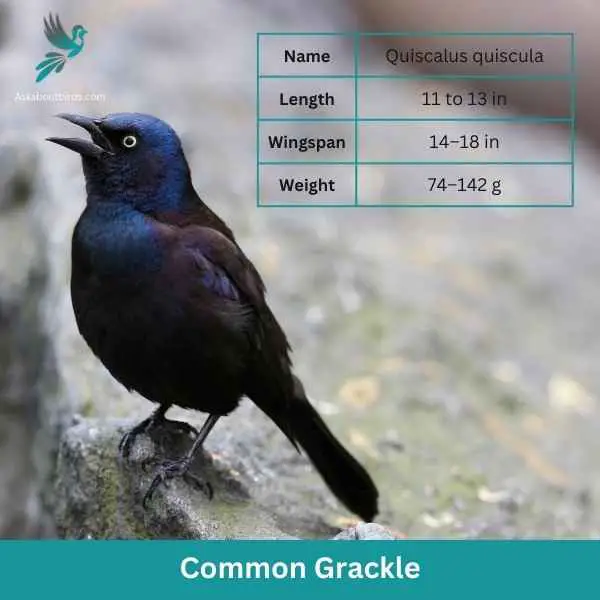

| Feature | Measurement |
|---|---|
| Scientific Name | Quiscalus quiscula |
| Length | 11 to 13 in |
| Wingspan | 14–18 in |
| Weight | 74–142 g |
The Common Grackle is a conspicuous bird found across much of North America, recognized for its glossy-black plumage, long tail, and piercing yellow eyes. Its vocalizations are varied and include a range of harsh, grating calls.
Appearance: The Common Grackle has a sleek black body with a glossy-iridescent sheen that can appear purple, green, or blue in certain lights. Its tail is long and keel-shaped. While both males and females have similar coloration, males are noticeably larger and shinier than females.
Diet: Common Grackles are omnivores. They primarily consume seeds, berries, and insects. However, they are also known to eat small fish, amphibians, and other birds’ eggs, especially when foraging on the ground or in shallow water.
Reproduction: Common Grackles breed in open and semi-open areas. The female typically selects the nest site and constructs a bulky nest made of grasses, twigs, and other plant materials, often in shrubs or trees. She lays a clutch of about 1 to 7 eggs, which are pale blue and spotted with brown.
Where to Spot Maine’s Blue Birds
Maine offers a plethora of locations that are perfect for bird watching, especially for those interested in blue birds. Here are the top 5 locations in Maine known for their great diversity of birds:
- Acadia National Park: This national park is home to over 300 bird species, including various species of blue birds. The diverse habitats within the park, from mountaintops to ocean shoreline, make it a prime location for birdwatching.
- Baxter State Park: Located in the heart of Maine, this state park is a haven for birdwatchers. The park’s vast forests and remote wilderness provide a home for many bird species, including the beautiful Eastern Bluebird.
- Scarborough Marsh: As the state’s largest salt marsh, it attracts a wide variety of bird species, including blue birds. The marsh is especially good for seeing migratory birds in the spring and fall.
- Down East Birding Trail: This trail spans over 200 miles along Maine’s coastline and includes several prime birdwatching spots. It’s an excellent area to spot various species of blue birds as well as other coastal and forest birds.
- Moosehorn National Wildlife Refuge: Located in eastern Maine, this refuge provides critical habitat for a variety of bird species, including several that are rare or endangered. It’s an excellent location to see blue-colored birds as well as other forest and wetland birds.
| Neighboring States | Top Spots for Blue Birds |
|---|---|
| New Hampshire’s Blue Birds | 1. White Mountain National Forest 2. Great Bay National Wildlife Refuge 3. Pondicherry Wildlife Refuge |
| Vermont’s Blue Birds | 1. Green Mountain National Forest 2. Missisquoi National Wildlife Refuge 3. Dead Creek Wildlife Management Area |
| Massachusetts’ Blue Birds | 1. Cape Cod National Seashore 2. Parker River National Wildlife Refuge 3. Quabbin Reservoir |
FAQs on Blue Bird Species Found in Maine
How to set up bluebird houses?
Attracting bluebirds and setting up houses involves careful consideration of location and design. Choose a location with scattered trees and open spaces, as bluebirds prefer such habitats. Install the bluebird houses 5-10 feet above the ground, and make sure the entrance faces away from prevailing winds and direct sunlight. Use a design with a predator guard and an easily accessible interior for monitoring and cleaning. Avoid using any chemicals or paint inside the house as it can be harmful to the birds.
What is the importance of old woodpecker holes for bluebirds?
Old woodpecker holes are crucial for bluebirds as they are secondary cavity nesters, meaning they cannot create their own nesting cavities. They depend on existing holes and cavities for nesting sites. Old woodpecker holes provide a natural and safe environment for bluebirds to nest and raise their young. Providing artificial nesting boxes is also important in areas where natural cavities are scarce.
What is the diet of bluebirds?
Bluebirds primarily feed on insects, making them an essential part of the food chain as they help control insect populations. Common insects in their diet include beetles, caterpillars, and grasshoppers. They also eat fruits and berries, especially during the winter months when insects are scarce. Providing supplemental food in their bird feeder like mealworms and sunflower seeds can be beneficial, especially during the winter and nesting seasons.
What is the indigo bunting range map?
The indigo bunting range map is a graphical representation of the geographical areas where the indigo bunting, a small bird with vibrant blue plumage, can be found. This map usually indicates the regions where these blue beauties are present year-round, where they breed, and where they spend the winter. Typically, indigo buntings breed in North America, from southern Canada to central and eastern United States, and migrate south to central America and northern South America for the winter.

